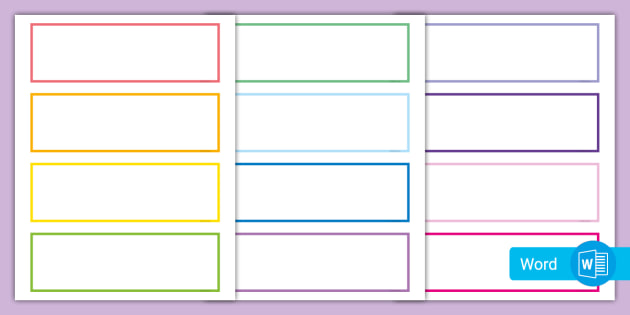Smudge-proof Blank Labels for professional printing.
Smudge-proof Blank Labels for professional printing.
Blog Article
Comprehending How Blank Labels Job to Enhance Your Labeling Experience
Understanding the technicians of blank labels is necessary for optimizing your labeling practices throughout different contexts. To fully understand how these labels can transform your procedures, one should take into consideration the different types readily available and the myriad ways they can be personalized to match particular requirements.

Benefits of Making Use Of Blank Labels
Blank labels use a flexible service for various labeling demands, making them vital in both personal and professional setups. Their adaptability permits individuals to develop personalized labels tailored to specific needs, improving business performance. Whether used in office, retail settings, or commercial applications, blank labels facilitate the recognition and categorization of items, papers, and personal things.
One significant advantage of blank labels is their cost-effectiveness. By permitting users to publish only the labels they need, waste is lessened, and inventory administration comes to be more workable. In addition, blank labels are compatible with different printing approaches, including inkjet and printer, making them easily accessible for various individuals.

Moreover, making use of blank labels streamlines the procedure of upgrading information, as users can conveniently publish new labels to replace outdated ones, ensuring that all items and papers are accurately labeled. In general, blank labels provide a sensible and effective labeling remedy for diverse applications.
Kinds of Blank Labels Available
What alternatives are offered when it involves blank labels? Blank labels come in a range of kinds, each fit for various applications and preferences. The most typical kinds consist of paper labels, which are versatile and economical, making them excellent for everyday use. They are offered in numerous coatings, such as matte and glossy, enabling aesthetic adaptability.
An additional preferred option is synthetic labels, frequently made from products like polyester or plastic. These labels are recognized for their resilience and resistance to water, chemicals, and tearing, making them appropriate for rough environments. They are typically utilized in industrial settings or for labeling products that may be subjected to dampness.
In addition, there are thermal transfer labels, which require a printer that utilizes warm to move ink onto the tag surface area. These labels are favored for their high-grade print and longevity.
Finally, specialty labels satisfy certain needs, such as removable labels for momentary usage or high-temperature labels for severe problems. Understanding these options allows users to select the most suitable blank label for their distinct labeling demands.
Modification Options for Labels
A broad range of modification alternatives is readily available for labels, permitting individuals to customize them to certain demands and branding demands. Individuals can select from various dimensions, forms, and materials to guarantee that the labels effectively fit their intended objective. Usual products include paper, polyester, and vinyl, each supplying various levels of resilience and aesthetic appeal.
Shade choices play an important function in customization, making it possible for brands to preserve consistency with their corporate identification. Individuals can select from a spectrum of shades or perhaps choose custom-made printing to match particular branding components. Furthermore, labels read what he said can be published with special designs, logos, and message, improving brand name recognition and aesthetic effect.
Another crucial aspect is the selection of adhesive. Labels can be created with permanent, detachable, or repositionable adhesives, depending on the application needs. This flexibility permits efficient labeling services throughout various settings, from retail to industrial setups.

Tips for Effective Labeling
Efficient labeling goes past personalization; it also includes strategic considerations that enhance capability and interaction. To accomplish efficient labeling, start by plainly specifying the objective of each tag. Consider the info that requires to be communicated and ensure it is presented in a simple way. Using succinct language and staying clear of jargon can significantly boost understanding.
Next, focus on visibility by picking suitable shades and font styles. High comparison between message and background boosts readability, while larger typefaces help with fast identification. Furthermore, ensure that labels are placed in a consistent and rational fashion, making it much easier for customers to find and analyze info.
Think about the durability of labels. Select products suited for the certain environment where the labels will be made use of, whether it be indoors or outdoors. Water resistant or tear-resistant alternatives may be needed relying on the context.
Lastly, consistently review and upgrade your labels to mirror any changes in info or use. This proactive method not only keeps clarity however likewise stays clear of confusion in time. By complying with these pointers, you can optimize the effectiveness of your labeling efforts, ensuring they serve their desired purpose efficiently.
Applications of Blank Labels
Blank labels provide various applications throughout numerous sectors, making them an important tool for organization and communication. These functional labels are commonly used in storage facilities for inventory administration, enabling services to quickly determine and track items. By using blank labels to storage bins, shelves, or pallets, business can enhance their procedures and reduce the possibility of errors.
In the healthcare industry, blank labels play an essential role in classifying drugs and clinical supplies, ensuring proper recognition and use. Customizable labels can include essential details such as dose, expiration dates, and person information, boosting safety and security and compliance.
In retail, blank labels assist in pricing products, providing promotions, or classifying shelf locations, which ultimately boosts the consumer experience. They enable fast updates to click to read prices or product information without the need for pre-printed labels.
Furthermore, blank labels are beneficial for individual usage, such as organizing office, crafting, or labeling food containers. Their adaptability permits people to produce tailored solutions that meet details requirements. In general, the applications of blank labels are considerable, emphasizing their relevance in fostering performance useful reference and quality in various settings.
Final Thought
In verdict, blank labels present a versatile and effective option for different identifying requirements. Inevitably, the assimilation of blank labels into operational processes contributes to enhanced effectiveness, making them a very useful resource for both personal and professional use.
Report this page